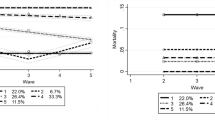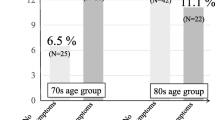Abstract
Objective
To investigate causal factors of functional impairment in old age in a longitudinal approach.
Design
A population-based prospective cohort study.
Setting
Elderly individuals were recruited via GP offices at six study centers in Germany. They were observed every 1.5 years over six waves.
Participants
Three thousand two hundred fifty-six people aged 75 years and older at baseline.
Measurements
Functional impairment was quantified by the Lawton and Brody Instrumental Activities of Daily Living scale (IADL) and the Barthel-Index (BI).
Results
Fixed effects regressions revealed that functional impairment (IADL; BI) increased significantly with ageing (β=-.2; β=-1.1), loss of a spouse (β=.5; β=-3.1), not living alone in private household (β=-1.2; β=-5.5), depression (solely significant for IADL: β=.6) and dementia (β=-2.3; β=-18.2). The comorbidity score did not affect functional impairment.
Conclusion
Our findings underline the relevance of changes in sociodemographic variables as well as the occurrence of depression or dementia for functional impairment. While several of these causal factors for functional decline in the oldest old are inevitable, some may not be, such as depression. Therefore, developing interventional strategies to prevent depression might be a fruitful approach in order to delay functional impairment in old age.



Similar content being viewed by others
References
Luppa M, Luck T, Weyerer S et al. Prediction of institutionalization in the elderly. A systematic review. Age Ageing 2010;39(1): 31–38. doi: 10.1093/ageing/afp202
Hajek A, Brettschneider C, Lange C et al. Longitudinal Predictors of Institutionalization in Old Age. PLOS ONE 2015;10(12): e0144203. doi: 10.1371/journal.pone.0144203
Reuben DB, Rubenstein LV, Hirsch SH et al. Value of functional status as a predictor of mortality: Results of a prospective study. Am J Med 1992;93(6): 663–669. doi: 10.1016/0002-9343(92)90200-U
Talegawkar SA, Tanaka T, Maras JE et al. Validation of nutrient intake estimates derived using a semi-quantitative FFQ against 3 day diet records in the Baltimore Longitudinal Study of Aging. J Nutr Health Aging 2015;19(10): 994–1002. doi: 10.1007/s12603-015-0518-8
Gomez-Gallego M, Gomez-Garcia J, Ato-Lozano E. Addressing the bias problem in the assessment of the quality of life of patients with dementia: Determinants of the accuracy and precision of the proxy ratings. J Nutr Health Aging 2015;19(3): 365–372
Chiu H, Chen C, Huang C et al. Depressive symptoms, chronic medical conditions and functional status: a comparison of urban and rural elders in Taiwan. Int J Geriatr Psychiatry 2005;20(7): 635–644
Friedman B, Heisel MJ, Delavan RL. Psychometric Properties of the 15-Item Geriatric Depression Scale in Functionally Impaired, Cognitively Intact, Community-Dwelling Elderly Primary Care Patients. J Am Geriat Soc 2005;53(9): 1570–1576
Iwasa H, Yoshida Y, Kumagai S et al. Depression status as a reliable predictor of functional decline among Japanese community-dwelling older adults: a 12-year population-based prospective cohort study. Int J Geriatr Psychiatry 2009;4(11): 1192–1200
Fujiwara Y, Yoshida H, Amano H et al. Predictors of improvement or decline in instrumental activities of daily living among community-dwelling older Japanese. Gerontology 2008;54(6): 373–380
Kelley-Moore JA, Ferraro KF. A 3-D model of health decline: Disease, disability, and depression among black and white older adults. J Health Soc Behav 2005;46(4): 376–391
Wang L, van Belle G, Kukull WB et al. Predictors of functional change: a longitudinal study of nondemented people aged 65 and older. J Am Geriat Soc 2002;50(9): 1525–1534
Hybels CF, Pieper CF, Blazer DG. The complex relationship between depressive symptoms and functional limitations in community-dwelling older adults: the impact of subthreshold depression. Psychol Med 2009;39(10): 1677–1688
Shinkai S, Kumagai S, Fujiwara Y et al. Predictors for the onset of functional decline among initially non-disabled older people living in a community during a 6-year follow-up. Geriatr Gerontol Int 2003;3(s1): S31–S39
Yang Y. Is old age depressing? Growth trajectories and cohort variations in late-life depression. J Health Soc Behav 2007;48(1): 16–32
Chen C, Mullan J, Su Y et al. The longitudinal relationship between depressive symptoms and disability for older adults: a population-based study. J Gerontol A Biol Sci Med Sc 2012;67(10): 1059–1067. doi: 10.1093/gerona/gls074
Ormel J, Rijsdijk FV, Sullivan M et al. Temporal and Reciprocal Relationship Between IADL/ADL Disability and Depressive Symptoms in Late Life. J Gerontol B Psychol Sci Soc Sci 2002;57(4): P338–P347. doi: 10.1093/geronb/57.4.P338
Fujiwara Y, Chaves PHM, Yoshida H et al. Intellectual activity and likelihood of subsequently improving or maintaining instrumental activities of daily living functioning in community-dwelling older Japanese: a longitudinal study. Int J Geriatr Psychiatry 2009;24(6): 547–555
Yang Y, George LK. Functional disability, disability transitions, and depressive symptoms in late life. J Aging Health 2005;17(3): 263–292. doi: 10.1177/0898264305276295
Hajek A, König H. Longitudinal Predictors of Functional Impairment in Older Adults in Europe–Evidence from the Survey of Health, Ageing and Retirement in Europe. PLOS ONE 2016; 11(1): e0146967. doi: 10.1371/journal.pone.0146967
Guralnik JM, LaCroix AZ, Abbott RD et al. Maintaining mobility in late life. I. Demographic characteristics and chronic conditions. Am J Epidemiol 1993;137(8): 845–857
Boult C, Kane RL, Louis TA et al. Chronic conditions that lead to functional limitation in the elderly. J Gerontol 1994;49(1): M28–M36
Dunlop DD, Semanik P, Song J et al. Risk factors for functional decline in older adults with arthritis. Arthritis Rheum 2005;52(4): 1274–1282
McGuire LC, Ford ES, Ajani UA. Cognitive functioning as a predictor of functional disability in later life. Am J Geriatr Psychiatry 2006;14(1): 36–42
Hajek A, Brettschneider C, Posselt T et al. Predictors of frailty in old age–results of a longitudinal study. J Nutr Health Aging: 2015;1–6. doi: 10.1007/s12603-015-0634-5
Luck T, Riedel-Heller SG, Luppa M et al. Risk factors for incident mild cognitive impairment—results from the German Study on Ageing, Cognition and Dementia in Primary Care Patients (AgeCoDe). Acta Psychiatr Scand 2010;121(4): 260–272. doi: 10.1111/j.1600-0447.2009.01481.x
Lawton MP, Brody EM. Assessment of older people: self-maintaining and instrumental activities of daily living. Gerontologist 1969;9(3): 179–186
Graf C. The Lawton instrumental activities of daily living scale. AM J NURS 2008;108(4): 52–62
Mahoney FI, Barthel DW. Functional Evaluation: The Barthel Index. Md State Med J 1965;14: 61–65
Brauns H, Steinmann S. Educational Reform in France, West-Germany and the United Kingdom. Updating the CASMIN Educational Classification. ZUMANachrichten 1999;44: 7–44
Yesavage JA, Sheikh JI. Geriatric Depression Scale (GDS) Recent Evidence and Development of a Shorter Version. Clin Gerontol 1986;5(1-2): 165–173
Reisberg B, Ferris SH, de Leon Mony J et al. The Global Deterioration Scale for assessment of primary degenerative dementia. Am J Psych 1982;139(9): 1136–1139
Cameron AC, Trivedi PK. Microeconometrics: methods and applications. Cambridge University Press, New York, 2005
Stock JH, Watson MW. Heteroskedasticity-robust standard errors for fixed effects panel data regression. Econometrica 2008;76(1): 155–174
Geerlings SW, Beekman AT, Deeg DJ et al. The longitudinal effect of depression on functional limitations and disability in older adults: an eight-wave prospective community-based study. Psychol Med 2001;31(8): 1361–1371
Liang J, Shaw BA, Bennett JM et al. Intertwining courses of functional status and subjective health among older Japanese. J Gerontol B Psychol Sci Soc Sci 2007;62(5): S340–S348
Bruce ML, Seeman TE, Merrill SS et al. The impact of depressive symptomatology on physical disability: MacArthur Studies of Successful Aging. Am J Public Health 1994;84(11): 1796–1799
Vaughan L, Giovanello K. Executive function in daily life: Age-related influences of executive processes on instrumental activities of daily living. Psychol Aging 2010;25(2): 343–355
Jefferson AL, Paul RH, Ozonoff A et al. Evaluating elements of executive functioning as predictors of instrumental activities of daily living (IADLs). Arch Clin Neuropsychol 2006;21(4): 311–320
Li LW. Predictors of ADL disability trajectories among low-income frail elders in the community. Res Aging 2005;27(6): 615–642
Gill TM, Williams CS, Richardson ED et al. A predictive model for ADL dependence in community-living older adults based on a reduced set of cognitive status items. J Am Geriatr Soc 1997;45(4): 441–445
Schillerstrom JE, Royall DR, Palmer RF. Depression, disability and intermediate pathways: a review of longitudinal studies in elders. J Geriatr Psychiatry Neurol 2008;21(3): 183–197
Penninx BW, Leveille S, Ferrucci L et al. Exploring the effect of depression on physical disability: longitudinal evidence from the established populations for epidemiologic studies of the elderly. Am J Public Health 1999;89(9): 1346–1352
Pohjasvaara T, Vataja R, Leppavuori A et al. Depression is an independent predictor of poor long-term functional outcome post-stroke. Eur J Neurol 2001;8(4): 315–319. doi: 10.1046/j.1468-1331.2001.00182.x
Xue Q, Fried LP, Glass TA et al. Life-space constriction, development of frailty, and the competing risk of mortality: the Women’s Health And Aging Study I. Am. J. Epidemiol. 2008;167(2): 240–248. doi: 10.1093/aje/kwm270
Dunlop DD, Manheim LM, Sohn M et al. Incidence of functional limitation in older adults: The impact of gender, race, and chronic conditions. Arch Phys Med Rehabil 2002;83(7): 964–971. doi: 10.1053/apmr.2002.32817
Hébert R, Brayne C, Spiegelhalter D. Factors associated with functional decline and improvement in a very elderly community-dwelling population. Am J Epidemiol 1999;150(5): 501–510
Gill TM, Allore HG, Holford TR et al. Hospitalization, restricted activity, and the development of disability among older persons. J Am Med Assoc 2004;292(17): 2115–2124
Kharicha K, Iliffe S, Harari D et al. Health risk appraisal in older people 1: are older people living alone an ‘at-risk’group? British Journal of General Practice 2007;57(537): 271–276
Arber S, Ginn J. Gender and inequalities in health in later life. Soc Sci Med 1993;36(1): 33–46. doi: 10.1016/0277-9536(93)90303-L
Perissinotto CM, Cenzer IS, Covinsky KE. Loneliness in older persons: a predictor of functional decline and death. Arch Intern Med 2012;172(14): 1078–1084
Kulmala J, von Bonsdorff Mikaela B, Stenholm S et al. Perceived stress symptoms in midlife predict disability in old age: a 28-year prospective cohort study. J Gerontol A Biol Sci Med Sc 2013;68(8): 984–991
Hajek A, Brettschneider C, Ernst A et al. Complex coevolution of depression and health-related quality of life in old age. Qual Life Res 2015;24(11): 2713–2722
Bickel H. Epidemiologie und Gesundheitsökonomie. In: Wallesch C (ed) Demenzen, 2., überarbeitete und erweiterte Auflage. Thieme, Stuttgart, 2012;pp 18–35
Moussavi S, Chatterji S, Verdes E et al. Depression, chronic diseases, and decrements in health: results from the World Health Surveys. Lancet 2007;370(9590): 851–858
Author information
Authors and Affiliations
Consortia
Corresponding author
Additional information
These authors contributed equally to this work.
Statistical analysis
To test whether FE regressions are necessary or the more efficient RE models can be used instead, we performed Sargan-Hansen test, resulting in the need to control for unobserved time-constant factors. Thus, FE regressions are the preferred regressions.
Alternate models
We repeated estimates (IADL as criterion) without comorbidity score (assessed from FU 2 upwards) as a covariate. Thus, in- traindividual changes from baseline up to FU wave 5 were used. Findings were almost the same (in terms of significant predictors and effect sizes) and the interaction term between depression and sex was significant (p=.001).
Furthermore, all analyses were repeated with FE poisson models, leading to similar results (in terms of significance) (results of alternate models are not shown, but are available upon request from the authors).
Additional models

12603_2016_771_MOESM3_ESM.gif
Table S3 Longitudinal Predictors of Functional Impairment (with interaction terms): Results of Fixed Effects Regressions
Rights and permissions
About this article
Cite this article
Hajek, A., Luck, T., Brettschneider, C. et al. Factors affecting functional impairment among elderly Germans — Results of a longitudinal study. J Nutr Health Aging 21, 299–306 (2017). https://doi.org/10.1007/s12603-016-0771-5
Received:
Accepted:
Published:
Issue Date:
DOI: https://doi.org/10.1007/s12603-016-0771-5






